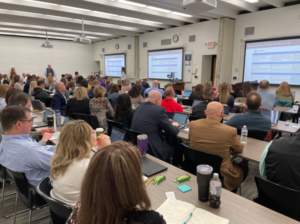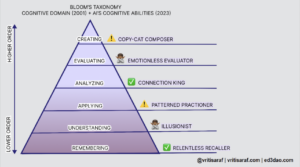What's a Superintendent to Do?
This all gets interesting when you consider the merged capabilities of:
- School of One, a personalized playlist of tailored learning objects,
- adaptive content and virtual learning environments,
- virtual and blended school models,
- a smart back end that tracks learning (an LMS with visual student profile),
- competency bundles (like Boy Scout merit badges) that mark progress and replace seat time and credits,
- and a platform that combines social learning, knowledge management, and aligned services for students, teachers, schools, and districts
So what’s a district or school network do in the next 36 months while we’re waiting for next generation platforms?
You can either wait and pilot some really cool stuff in 2-3 years or start with a couple pilots and plan on a merge at scale 3-4 years down the road.
If you’re a superintendent and don’t have a virtual offering, start one in September (even if your state doesn’t have an online learning law…ask forgiveness, they’ll all need to catch up soon). There are enough capable partners that there’s no excuse for not having quality credit recovery options or advanced college credit options for all students. Most virtual options this fall will still be first gen—flat and sequential—but many are still better than nothing and often supported by very capable teachers online. There’s simply no way to offer high level STEM in most districts without incorporating online learning.
If you issue an RFP for a virtual partner, make sure you ask them about supporting blended models (schools where responsibility shifts online for part of the day) and tell them you want to hire as many local teachers as possible. Figure out how blended models can save you money, because in most state there won’t be any extra money for a while.
It’s also a good time to rethink your LMS. Make sure you’ve got one that allows you to add open and teacher generated content. Join or create a content consortium that shares standards aligned content. And start thinking about the policy implications of mastery-based progress in your state and district.
Here’s a calendar of events for a district that doesn’t current offer any/many virtual options:
1. Launch credit recovery and college credit options Sept 2010 with a three year vendor partnership
goal 1: quickly expand quality options and college-ready grad rates
goal 2: introduce blended concept to existing schools
2. Launch a blended high school (or academy) Sept 2010 preferably with the same content vendor as above
goal 1: expand quality high school options
goal 2: demonstrate blended model (tiered staffing, progress on mastery)
3. Start thinking about second-generation virtual options (i.e., personalized lessons replace one-size-fits-some courses) by reviewing your LMS capabilities and planning a 2011 upgrade.
goal: personalized learning
4. Identify some partners and begin reviewing open and proprietary content; plan to move most instructional content online by fall 2011 (or 2012 if access is a challenge).
goal: increase quality and decrease cost of instructional material
5. Launch a full k-12 virtual school fall 2011–a combination of comprehensive first generation content and partial second generation content–with support/incentives for blended adoptions.
goal: Target 2012 to convert all secondary schools to blended models with upper division students doing at least third of their work online.
How do you pay for it? Big districts can do much of this by spending other people money. Small districts will need to work together in networks. By the time you get to #5, you can have better system that costs less, but you’ll have a few tough choices to make along the way.
This (highly simplified) approach will obviously take great program management, strong communications, partnership development, and a lot of professional development. Done right, it will be worth the effort.






0 Comments
Leave a Comment
Your email address will not be published. All fields are required.